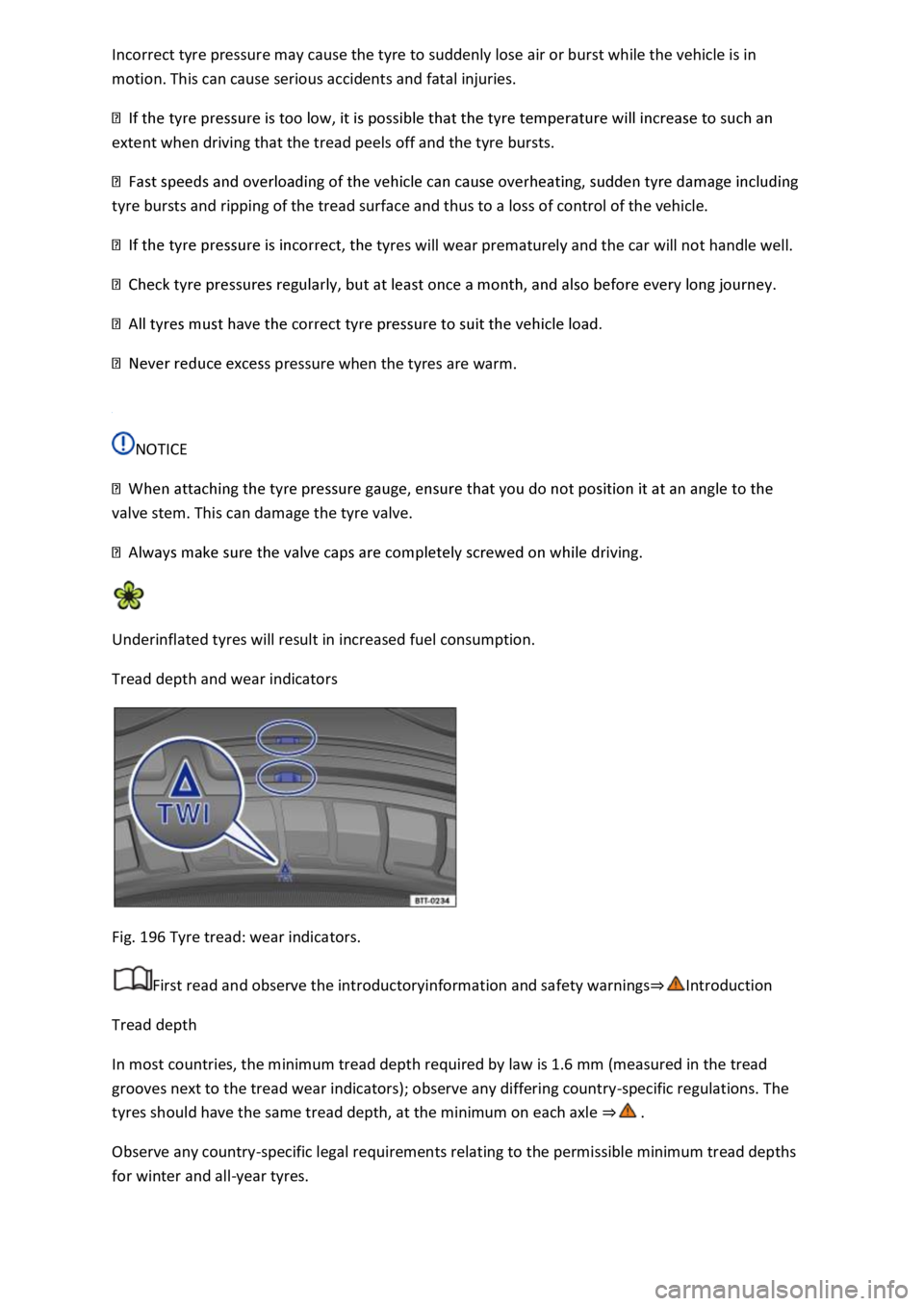Page 395 of 502

Tyre Pressure Loss Indicator. In the event of a malfunction, the indicator lamp will flash for 65
seconds and then light up continuously. However, the indicator lamp will go out when the road
conditions or driving style change.
Useful information about wheels and tyres
Introduction
This chapter contains information on the followingsubjects:
Handling wheels and tyres
Wheel rims and wheel bolts
Tyre pressure
Tread depth and wear indicators
Tyre damage
Spare wheel or temporary spare wheel
Tyre lettering and tyre type
Maximum load and speed range for tyres
Winter tyres
Snow chains
The tyres are the most heavily loaded and most underestimated parts of a vehicle. Tyres are very
important as the narrow tyre contact surfaces are the only contact between the vehicle and the
road.
The service life of tyres is dependent on tyre pressure, driving style, handling and correct fitting.
WARNING
New tyres or tyres which are old, worn down or damaged cannot provide full vehicle control and
braking efficiency.
injuries.
s must be fitted with radial tyres of the same type, size (rolling circumference) and
the same tread pattern.
particularly carefully for the first 600 km in order to prevent accidents and serious injury.
the tyre pressure is too low, it is possible that the tyre temperature will increase to such an extent
when driving that the tread peels off and the tyre bursts.
Page 398 of 502

lace tyres at least on an axle-by-axle basis
type.
-approved tyres.
Re-synchronising the Tyre Pressure Loss Indicator
The Tyre Pressure Loss Indicator must be re-synchronised each time one or more wheels is changed.
This also applies if the wheels have been swapped, e.g. from the front to the rear Tyre monitoring
system
WARNING
Aggressive liquids and other substances can cause visible and invisible damage to the tyres, which
can cause the tyre to burst.
from the tyres.
WARNING
Even if they have not been used, old tyres can suddenly lose pressure or burst, especially at high
speeds, and thus cause accidents and serious injuries.
ith
extra care at all times.
WARNING
New tyres must be run in as they initially have reduced grip and braking efficiency.
km in order to prevent accidents and serious injury.
WARNING
Wheels must have the necessary clearance. If the wheels do not have the necessary clearance, the
tyre could rub on parts of the running gear, vehicle body and the brake lines. This can lead to a fault
in the brake system and to tread separation and thus to a tyre bursting.
and must not rub on any vehicle body parts.
Page 402 of 502

suddenly lose air or burst while the vehicle is in
motion. This can cause serious accidents and fatal injuries.
extent when driving that the tread peels off and the tyre bursts.
tyre bursts and ripping of the tread surface and thus to a loss of control of the vehicle.
tyres will wear prematurely and the car will not handle well.
s pressure when the tyres are warm.
NOTICE
valve stem. This can damage the tyre valve.
iving.
Underinflated tyres will result in increased fuel consumption.
Tread depth and wear indicators
Fig. 196 Tyre tread: wear indicators.
First read and observe the introductoryinformation and safety warnings
Tread depth
In most countries, the minimum tread depth required by law is 1.6 mm (measured in the tread
grooves next to the tread wear indicators); observe any differing country-specific regulations. The
tyres should have the same tread depth, at the minimum on each axle
Observe any country-specific legal requirements relating to the permissible minimum tread depths
for winter and all-year tyres.
Page 403 of 502

The tread wear indicators show if a tyre is worn down. The tyre must be replaced at the latest when
the tread is worn down to the tread wear indicator.
The bottom of the tyre tread has 1.6 mm high tread wear indicators Fig. 196
tyre sidewall indicate the position of the wear indicators Fig. 196
WARNING
Worn tyres are a safety risk and can lead to a loss of control over the vehicle and cause serious
injuries.
indicators.
roads, which can cause the vehicle to
float along the road surface (aquaplaning).
situations and increase braking distance and the risk of skidding.
Tyre damage
First read and observe the introductoryinformation and safety warnings
Damage to tyres and wheel rims is often hidden
and wheel rims for damage.
Changing a wheelor seal the
tyre with the breakdown set and inflate it Breakdown set
, drive slowly and carefully to the next qualified workshop in order to
have the vehicle checked.
Foreign bodies in the tyre
between the tyre tread blocks can be removed.
Changing a wheelor seal the tyre with the breakdown set and
inflate it Breakdown set
olkswagen recommends using a Volkswagen dealership for this
purpose.
Tyre wear
Fast cornering, heavy acceleration and hard braking all increase tyre wear.
Page 405 of 502

r remove the luggage compartment floor Luggage compartment floor
centre hole in the rim is positioned exactly above the hole or threaded pin.
overing in the luggage compartment if necessary.
Luggage compartment floor
If the spare wheel tyre is not the same as the tyres on the vehicle
If the spare wheel tyre differs from the other tyres on the vehicle, the spare wheel must be used
only in the event of a tyre failure and for a short time
Observe these driving notes:
km/h (50 mph).
not use snow chains on the temporary spare wheel Snow chains
spare wheel Tyre pressure
WARNING
Incorrect use of the spare wheel or temporary spare wheel can lead to a loss of control over the
vehicle, collisions or other accidents and cause serious injuries.
wear indicators.
ped with a temporary spare wheel instead of a spare wheel. The
temporary spare wheel can be recognised by a sticker and the text 80 km/h or 50 mph. This is the
maximum speed at which you are permitted to drive with this tyre. The sticker must not be covered
during use of the wheel.
km/h (50 mph. Do not accelerate quickly, brake suddenly or drive at
high speed through bends.
km with a temporary spare wheel if it is fitted to the drive axle.
Page 413 of 502
WARNING
The use of snow chains that are unsuitable for your vehicle or the incorrect installation of snow
chains can cause accidents and serious injuries.
the maximum speed permitted for the snow chains that are fitted.
NOTICE
otherwise impair handling, damage the tyres and wear out very quickly.
t are in direct contact with the wheel rim can scratch or damage it. Volkswagen
recommends using snow chains with built-in rim protection.
In vehicles with a Tyre Pressure Loss Indicator, the system must be re-synchronised after snow
chains are fitted Tyre monitoring system
Hubcaps
Centre wheel trim
Fig. 199 Removing the centre wheel trim by pulling.
Page 417 of 502

observe the following steps in order to reduce the risk of serious injuries:
as soon as possible and when safe to do so. Park the vehicle at a safe distance
from moving traffic in order to carry out the wheel change.
work during the wheel change.
board or similar support for the vehicle jack.
urself when you feel confident with carrying out the procedure. If not,
seek expert assistance.
ver
to the position P or select a gear on a manual gearbox in order to reduce the risk of unintended
vehicle movement.
immediately after changing a wheel.
n the case of vehicles with a Tyre Pressure Loss Indicator, the system must be re-synchronised
immediately after a wheel changeTyre Pressure Loss Indicator
Preparations for changing a wheel
First read and observe the introductoryinformation and safety warnings
Checklist
The following actions must always be carried out in the given order in preparation for changing the
wheel
If your vehicle has a flat tyre, park the vehicle on a firm and level surface at a safe distance from
moving traffic.
Switch on the electronic parking brake Parking and manoeuvring.
DSG
Page 424 of 502

theft wheel bolt using the adapter at position Fig.
0
l the other wheel bolts in clockwise direction and tighten them slightly.
tighten the bolts in order but always in diagonally opposite sequence.
Hubcaps
WARNING
Incorrect tightening torque or incorrect use of wheel bolts can lead to a loss of control of the vehicle,
and cause accidents and serious injuries.
ep all wheel bolts and threads in the wheel hubs clean and free from oil and grease. The
wheel bolts must be easy to turn and be tightened to the specified torque.
not use
for loosening or tightening them.
After changing a wheel
First read and observe the introductoryinformation and safety warnings
luggage compartment Vehicle toolkit
Tightening torque of wheel
bolts
as possible.
After changing a wheel, the indicator lamp for the tyre monitoring system may indicate a fault in the
system T
Breakdown set
Introduction
This chapter contains information on the followingsubjects:
Contents of the breakdown set
Preparations
Sealing and inflating tyres